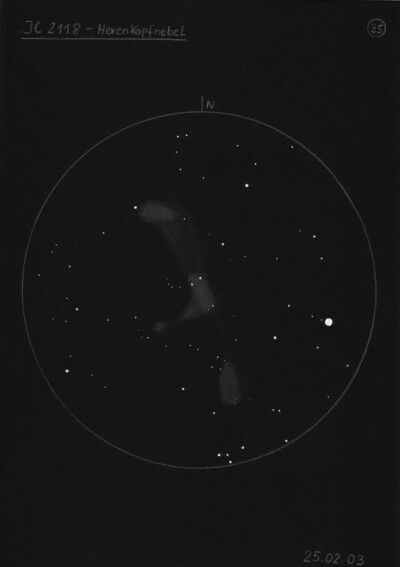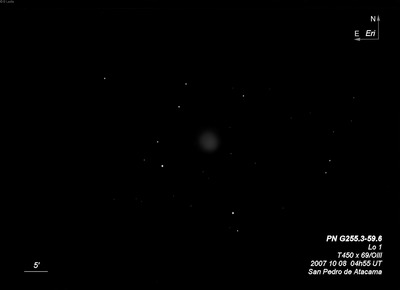A large constellation of the southern sky lying southwest of Orion. This, the sixth largest constellation, winds its way across a respectable portion of the sky in the evening in late autumn and during the winter: it originates at the bright Rigel in Orion and winds its way further down to the west and south. Of all the constellations, it has the greatest range of declination (60 degrees). The water stream is mostly made up of 3rd and 4th magnitude stars, so that it is lost in places if you are not looking closely. The mouth of the river is marked by the first magnitude star Achernar, which is not visible from our latitudes because it lies at a declination of almost -60˚. There are many galaxies in Eridanus, the most visually beautiful of which are NGC 1232 and NGC 1300.
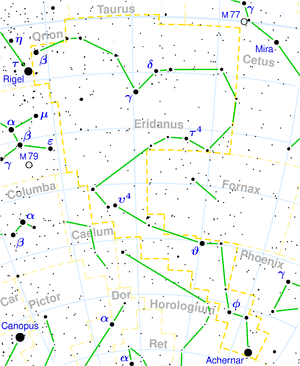
Achernar (α Eri) - The brightest star of the constellation and the ninth brightest star in the entire sky. It does not rise above the horizon in our location, and it begins to appear above the horizon at a height of three degrees from the regions of Texas, Morocco, and Egypt. This pale blue star with a surface temperature of 15,000 ˚C has a magnitude of 0.5 on the sky and is located 139 light-years away from us. Its absolute luminosity is 3150 times greater than that of the Sun. Nearby, there is a wide double star p Eridani, whose components with a brightness of 6 mag can be distinguished with a small telescope.
Acamar (θ Eri) - This star is believed to have weakened from 1st to 3rd magnitude in the historical period, although there is not enough evidence for it. However, it is a very beautiful binary star, with its white companions having a brightness of 3.4 mag and 4.5 mag, and they are 8.2" apart. To resolve this pair, a telescope with a 5 cm diameter objective is sufficient. However, due to its low declination, this system is very difficult to observe in our country.
ε Eri - This solitary dwarf star (3.7 mag) is essentially similar to our Sun in size, spectral type, and luminosity. It has a small rotational velocity, suggesting the possibility of having planets around it. ε Eri is the third closest star, visible to the naked eye at a distance of 10.76 light-years. Radio telescopes are monitoring it in search of potential signals from a civilization that could potentially inhabit one of the presumed planets.
Keid (ο2 Eri) - Interesting triple star system, consisting of a yellow star (4.4 mag) similar to our Sun, and another component at a separation of 83.4", which can be clearly resolved into two stars in a larger telescope: a red star (11.2 mag) and a white dwarf (9.4 mag), currently separated by 7.6". Try to distinguish them with a 100 mm telescope.
32 Eri - Contrasting double star observable even with a small telescope. Its companions with magnitudes 4.8 and 6.1 are separated by 6.8". The primary component is dark yellow, while the companion is green-white.
NGC 1232
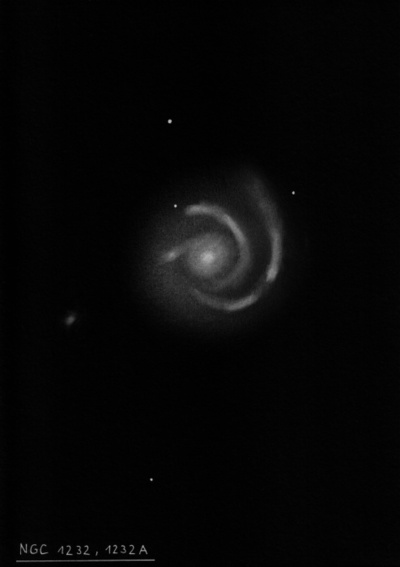
William Herschel discovered NGC 1232 = H II-258 = h2509 on 20 Oct 1784 (sweep 303) recording "eF, lbM, 7 or 8' dia." On 19 Dec 1799 (sweep 1091) he logged "F, cL, bM, irr F, 5 or 5' diam. The nebulosity is unequal, seeming to be two or three clouds or nebulosities joined together." John Herschel made 3 observations at the Cape. His most detailed observation reads, "B; vL; R; resolvable; 3' (dia), first very grad then psbM. With the left eye I see it mottled. (N.B. This is no doubt a distant globular cluster)."
Based on a photograph taken at the Helwan observatory in 1921-22, NGC 1232 was described as "pB, 7'x7', open spiral, B stellar nucleus, many branches with almost stellar condensations." NGC 1232B = PGC 11834, near the end of one of the spiral arms, was assumed to be interacting with NGC 1232, but its redshift places it four times the distance. Due to the apparent discordan redshift, NGC 1232/1232A was used by Arp to argue against redshift-based distances.
200/250mm - 8" (10/13/81): faint, diffuse, low surface brightness.
300/350mm - 13.1" (1/18/85): large, large bright core, substellar nucleus, very diffuse outer halo. An arm is suspected attached at the west end and winding towards the east on the north side of the core.
400/500mm - 17.5" (10/8/88): bright, large, slightly elongated, bright core, very large faint halo. Located 8' WSW of mag 8.6 SAO 168347.
600/800mm - 30" (10/15/15 - OzSky): NGC 1232 is a face-on multi-arm knotty Sc-type. At 303x it appeared very bright, very large, roundish, at least 6' diameter. It was sharply concentrated with a very bright, elongated core that contained a brighter central bar-like nuclear region. Spiral structure was evident in the large halo, but more subtle than I expected as several segments were disconnected. The most prominent was a knotty arm on the north side. It emerged near the northwest end of the core and shot linearly (2' length) towards the northeast in the direction of a mag 14 star 2.5' NE of center.
Another spiral arm extended east and west perhaps 1.5' length, just south of the central region. The arm faded out at its west end but after a short break, a very faint elongated knot, ~14"x8", was visible 1.7' WSW of center. NED includes multiple designations NGC 1232:[HK83] 442, [HK83] 445, [HK83] 450 and more from Hodge and Kennicutt's 1983 "Atlas of HII regions in 125 galaxies". The arm dimmed again but could just be traced shooting straight N-S in the northwest end of the halo. Another short, linear segment of a arm (containing [HK83] 110) was just visible close east of the core, 1.1' ENE of center.
NGC 1232A (the subject of a long-standing redshift controversy) was visible 4.1' ESE of center, just beyond the east edge of the galaxy. It appeared very faint, small, round, ~20" diameter
Notes by Steve Gottlieb
NGC 1300
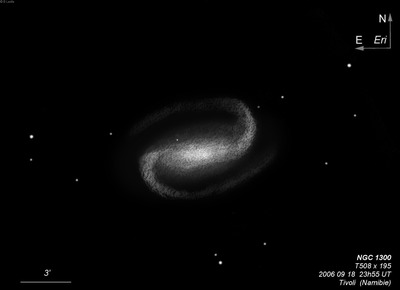
John Herschel discovered NGC 1300 = h2522 on 11 Dec 1835, recording "B; vL; 1st very gradually then pretty suddenly vmbM; 3' l; 2' b; mE. (N.B. These dimensions can only refer to the brighter portions.)" His second descriptions reads: "pF, vL; 1st gradually then pretty suddenly bM to a F nucleus; mE 8' or 10' l, 2' b.". Herschel's position (2 observations) is accurate but in the GC he accidentally placed GC 689 = NGC 1300 one degree too far south Barnard caught this error (Sidereal Messenger 4, p125) and Dreyer corrected the position while compiling the NGC.
200/250mm - 8" (10/13/81): faint, fairly large, elongated, low surface brightness, diffuse.
400/500mm - 17.5" (8/31/86): fairly bright, elongated ~E-W, bright core, stellar nucleus. A spiral arm is visible at the west end of the central bar curving to the north. NGC 1297 lies 20' NNW.
600/800mm - 30" (10/15/15 - OzSky): beautiful classic barred spiral at 303x! A prominent 3' bar runs WNW-ESE and contains a very bright, roundish 1' core that gradually brightens to the center. An easily visible arm is attached at the east end of the bar. It hooks sharply to the west on the south side, gradually curling towards the north. The arm has a fairly even surface brightness except where is attaches to the bar in a brighter, thicker section. It ends nearly due west of the core [2.2' from center]. An opposing arm is attached at the west end of the bar and is brightest initially along a clumpy section (containing at least 2 resolved knots) angling from southwest to northeast. The central section of the northern arm (directly north of the core) has a very low surface brightness but it brightens in a thin section near the east end. The two main arms extend at least 4.5'x3' ~E-W
900/1200mm - 48" (10/25/14 and 10/29/16): the northern spiral arm is brightest and thickest in the 1' section, oriented SW-NE, where it attaches to the bar. At 375x and 488x at least three knots (HII complexes) were clearly resolved along this region. The brightest knot is on the southwest end (close to the end of the bar) and appears as a very faint, small, elongated glow, ~12"x8". This HII complex contains NGC 1300:[H69] 16/19 from Paul Hodge's 1969 "HII Regions in Twenty Nearby Galaxies" (ApJS, 18, 73). [H69] 15, the next brightest knot, is 0.3' NE and appeared very faint and small, ~8" diameter. Finally, [H69] 14, the faintest knot, is near the northeast end of this arm segment (~15" NE of [H69] 15) and is extremely faint and small, 6" diameter. The northern arm appears to fade out as it extends east (north of the core) but reappears along the eastern end of the arm.
The root of the southern arm at the east end of the bar is brighter and thicker, but no HII regions were resolved. The long southern arm could be traced the full length (nearly 4') sweeping west and arcing north on its western half. A small, weak knot is at the very tip, which is 2.5' W of center (on line with the bar).
48" (10/25/11): this prototype barred spiral was mesmerizing at 375x. Running roughly E-W through the center is a long bright bar, ~3' in length. The center is sharply concentrated with an intensely bright 1' core that continues to increase to a stellar nucleus. At the west end of the bar, a fairly bright arm emerges and hooks back dramatically to the east (counterclockwise) to the north of the bar and continues to the northeast end of the galaxy. The arm is brightest in a thick arc, oriented SW-NE, where it attaches to the bar. The central section of the arm to the north of the core is slightly fainter and then brightens slightly on its northeast end. A mag 15.5-16 star is superimposed in the gap between this arm and the core, 45" NE of center. The second arm emerges at the east end of the bar and is brightest initially in a fairly thick arc extending counterclockwise to the southwest. This arm is slightly more separated from the core as it gracefully curves to the southwest side of the galaxy. The two main arms increase the overall size of the galaxy to 5'x3' WNW-ESE.
Notes by Steve Gottlieb
NGC 1531
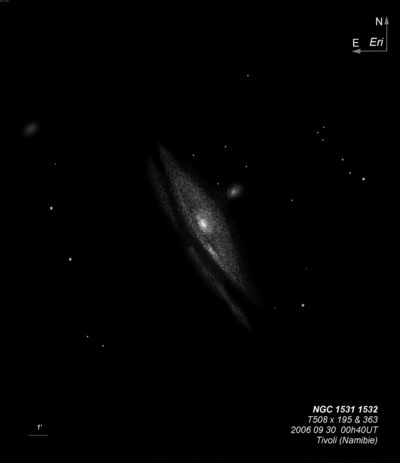
John Herschel discovered NGC 1531 = h2620 on 19 Oct 1835 and recorded "faint, round, brighter in the middle, 60". The preceding of two [with NGC 1532]." His position (measured on 3 sweeps) is accurate.
300/350mm - 13.1" (12/22/84): moderately bright, small, slightly elongated. Forms a close pair with larger and brighter NGC 1532 1.6' SE.
900/1200mm - 48" (10/22/11): very bright, moderately large, oval ~2:1 NW-SE, 1.2'x0.7', well concentrated with a very bright core. Forms a beautiful pair with the stunning edge-on NGC 1532 and situated just 1.7' NW of the core of the larger galaxy. In addition, the major axis of NGC 1531 is angled directly perpendicular to the core of NGC 1532. Several stars surround the galaxy.
Notes by Steve Gottlieb
NGC 1535
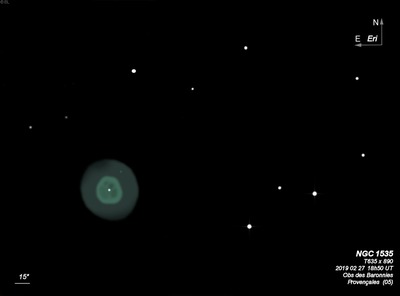
13x80mm finder (1/15/07): fairly bright stellar object at 13x in my 80mm finder and very easy to identify with blinking. Appears as a soft bluish star at 25x and definitely non-stellar at 32x and 54x.
William Herschel discovered NGC 1535 = H IV-26 = h2618 on 1 Feb 1785 (sweep 364) and recorded "a very curious planetary, vB of a uniform brightness all but the edges which are ill defined; about half a minute in diam. With 240 proportionally magnified, perfectly R or perhaps a little elliptical." On a second observation he called it resolvable on the borders, and probably a very compressed cluster of stars at an immense distance. From the Cape of Good Hope, JH recorded "B; S; R; first pretty suddenly, then very gradually brighter in the middle; 20" across. A mottled disc, but so hazy at the borders that I have no doubt of its being a very distant and highly compressed globular cluster. It is not a planetary nebula, though a near approach to one: does not bear magnifying. A power of 320 is of no use. A very remarkable and interesting object." Possibly irregularities in the rim influenced JH to believe it was a GC.
William Lassell observed NGC 1535 on 7 Jan 1853 with his 24-inch equatorial reflector from Malta and commented, "the most interesting and extraordinary object of the kind I have ever seen. A bright well-defined star, perhaps 11th magnitude, right in the centre of a circular nebula, whose edge was the brightest part; and this nebula again placed upon a larger and fainter, concentric and equally symmetrical." His sketch was published in his 1854 MRAS paper (figure 4) on observations from Malta. He sketched it again in 1862 with his 48-inch and wrote, "An extraordinary and beautiful Planetary Nebula powers 760 and 1060. The circumferential nebula fades away at its upper margin and the lowe and opposite part of the circumference is less strongly defined than the preceding and following sides. Moreover, the nucleus does not seem stellar, but a small patch of bright light."
Ralph Copeland, made a detailed observation using Lord Rosse's 72" on 19 Dec 1873: "blue planetary nebula. A small stellar nucleus with a bright atmosphere surrounded by a fainter one [double-shell structure]. There is a very small vacuity close to and sf the nucleus - power 414. Outside diam np and sf = 45.1"; diameter of bright atmosphere = 18.4". With power 625 the nucleus seems quite granular and surrounded by a narrow dark ring extending quite round. Position of two of the most conspicuous central granules = 81.2?."
Sherburne Wesley Burnham, observing with the Lick 36-inch refractor, commented "besides the central star, there are other fainter stars within the nebula. The most prominent of these is near the northern edge of the circular disc... The 14.5m star does not seem to have been seen by other observers [Lassell noted a faint star just inside its preceding edge]." Burnham measured the position of this star at 16" in PA 324? (NW) of the central star.
200/250mm - 8" bright, greenish, fairly small, round.
300/350mm - 13" (12/22/84): at 360x the central star visible surrounded by two shells. The bright inner shell has a small dark annulus surrounding the central star and the outer envelope is fainter and more diffuse.
400/500mm - 17.5" (12/30/99): this planetary has beautiful, bluish double-shell structure which was very evident at 100x surrounding a bright central star. The view at 380x and 500x was superb in good seeing. The double shell envelope was very prominent with a bright inner ring, ~20" diameter, with a fairly sharp edge embedded in a fainter roundish halo roughly doubling the diameter. The inner shell was irregularly darker surrounding the central star.
17.5" (2/8/91): very bright, fairly small, high surface brightness, mag 12.5 central star visible, blue color. This planetary has a double shell structure with inner shell slightly elongated and a faint rounder outer shell. Small dark gaps are visible around the central star.
600/800mm - 24" (11/24/14): I didn't take notes, but at 500x a mag 14.5-15 star was faintly visible near the northwest edge of the outer shell [16" from center].
900/1200mm - 48" (11/1/13): at 813x, this gorgeous planetary displayed an extremely bright, green double-shell structure. The 20" diameter inner ring was quite striking with slight irregularities in thickness and brightness and a very slight elongation. The darker interior of the inner ring was mottled with subtle darker and brighter patches around the mag 12.5 central star. The outer shell doubled the diameter and was slightly elongated ~N-S, 40"x35", with a mag 14.5-15 star superimposed on the NW side [16" from the central star]. With extended viewing there appeared to be subtle variations in brightness, almost like radial striations in the outer and inner shell. (Similar view on 10/23/14).
Notes by Steve Gottlieb
NGC 1395
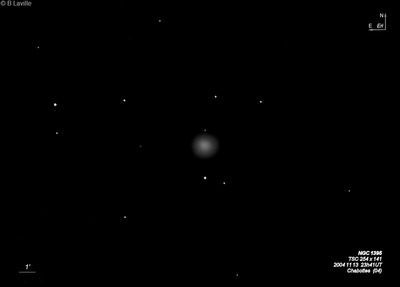
William Herschel discovered NGC 1395 = H I-58 = h2566 on 17 Nov 1784 (sweep 321) and logged "B, S, lE, mbM." JH recorded "vB, pmE, psmbM, 60" long", and measured an accurate position (2 sweeps).
200/250mm - 8" (10/13/81): fairly bright, small, round, small bright core.
300/350mm - 13.1" (10/10/86): bright, fairly small, oval 4:3 ~E-W, very bright core, fainter halo. Two faint mag 14 stars lie on the west and north edges 1.0' from center. Brightest in a group of five with NGC 1401, NGC 1403, NGC 1415 and NGC 1416 and the leading member of the larger Eridanus Group.
Notes by Steve Gottlieb
NGC 1407
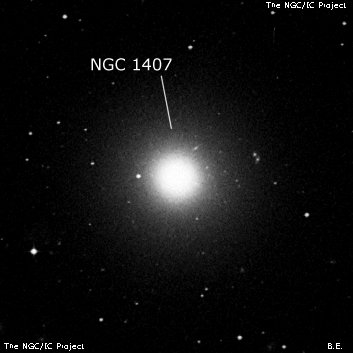
William Herschel discovered NGC 1407 = H I-107 = h2570 on 6 Oct 1785 (sweep 459) and recorded "B, R, mbM or large nucleus, about 1.5' diameter." JH logged it as "vB, L, R, first vg then vs, vmbM; 3'."
200/250mm - 8" (10/13/81): bright, small, round, small bright core.
300/350mm - 13.1" (1/18/85): bright, fairly small, bright core, stellar nucleus. Forms a wide pair with NGC 1400 11.6' SW.
400/500mm - 17.5" (12/11/99): bright, moderately large, round, 1.5' diameter, bright core, nearly stellar nucleus. Brightest in the NGC 1407 Group (LGG 100), which includes 8 NGC galaxies and IC 343.
600/800mm - 24" (1/1/19): at 260x; very bright, very large, round, 2.5'-3' diameter. The galaxy displayed three distinct brightness zones that were sharply delineated. The large halo was fairly smooth, but the sharply concentrated with a very bright core. The core has a sharp brightness spike with an extremely bright nucleus!
A number of galaxies are nearby including NGC 1400 11.5' SW, NGC 1402 10' WNW, IC 343 8' N, IC 345 21' NE, IC 346 29' NE and several more.
Notes by Steve Gottlieb
NGC 1332
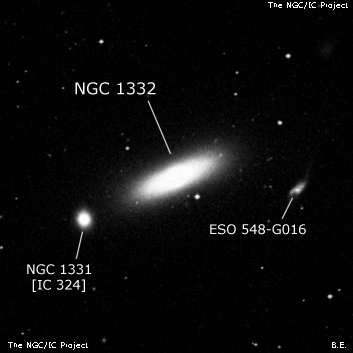
William Herschel discovered NGC 1332 = H I-60 on 9 Dec 1784 (sweep 331) and logged "vB, S, lE, mbM." On 19 Dec 1799 (sweep 1091) he recorded "Two [along with NGC 1331], the 1st [NGC 1332] vB, SBNcl with faint branches from np to sf." The position of NGC 1331 is too far west in the NGC, so the pair is out of RA order.
Joseph Turner sketched the pair on 26 Nov 1875 with the Great Melbourne Telescope (unpublished plate II, figure 9) as well as Pietro Baracchi on 7 Jan 1885.
200/250mm - 8" (12/6/80): fairly bright, fairly small, elongated NW-SE, bright core, diffuse halo. NGC 1331 not seen.
300/350mm - 13.1" (10/10/86): bright, moderately large, very bright core, edge-on 4:1 NW-SE, 2.4'x0.6'. A faint mag 14-14.5 star is just southwest of the core. Forms a pair with NGC 1331 = IC 324 2.8' SE (collinear with the major axis). NGC 1332 is the brightest in a group with NGC 1315, NGC 1319, NGC 1325, NGC 1331 and Holmberg VI NGC 1325A).
Notes by Steve Gottlieb
NGC 1537
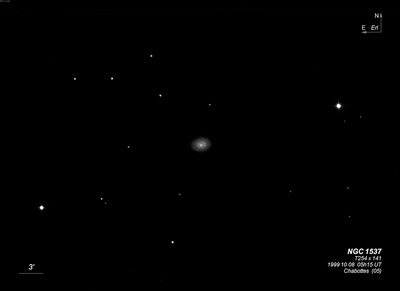
John Herschel discovered NGC 1537 = h2624 on 18 Nov 1835 and recorded "vB, lE, psvmbM, 50" l, 40" br." His position is 5' N of ESO 420-012 = PGC 14695, but the identification is secure.
300/350mm - 13.1" (1/18/85): fairly bright, moderately large, elongated 3:2 ~E-W, prominent elongated core, stellar nucleus. Member of the NGC 1532 group (LGG 111).
Notes by Steve Gottlieb
NGC 1187
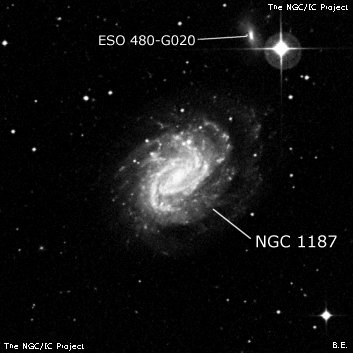
William Herschel discovered NGC 1187 = H III-245 = h2504 on 9 Dec 1784 (sweep 331) and noted "vF, cL, iE, resolvable, unequally bright." JH described the galaxy from the Cape as "bright; very large; pretty much elongated; very gradually brighter to the middle; 3.5' long, 2.5' broad; has in or near the middle a star 16 mag." E.E. Barnard observed the nebula on 23 Aug 1883 and was surprised Herschel called it "vF", as it was not difficult in his 5-inch refractor.
The galaxy was photographed by Harold Knox-Shaw at the Helwan Observatory between 1909-11 with the 30" Reynolds reflector and described as a "spiral with curious faint extensions". Photographs taken in 1919-20 with the new 30" mirror showed "spiral with many braches in which are a great many almost stellar condensations; pF stellar nucleus through which is a vF line in p.a. 115? [central bar], giving the central portion a Phi type appearance ([barred ring]."
200/250mm - 8" (10/13/81): faint, fairly large, elongated, diffuse. Located 4.7' SE of a mag 9 star.
400/500mm - 17.5" (11/26/94): moderately bright, fairly large, 4'x3' NW-SE. Elongated in the direction of mag 8.8 SAO 168248, which is 4.7' NW of center. Broad concentration to an ill-defined core which contains a faint but distinct stellar nucleus.
900/1200mm - 48" (10/27/19): at 375x; very bright, very large spiral with a bright elongated core oriented WNW-ESE. The inner portion of the halo was clearly blotchy. A brighter arc or patch was just SE of the core and another brighter arc as close E and NE of the core. Finally, a subtle brighter patch was NW of the core. These brighter spiral segments formed a pseudo-ring oriented WNW-ESE. The outer halo was diffuse and extended ~4.5'x3.25', reaching a mag 15.9 star 1.9' N of center. Another 16th mag star was in the outer halo on the NE side. Located 4.6' SE of mag 8.8 HD 18967.
ESO 480-20, located 4.5' NNW, appeared faint, low surface brightness, elongated N-S, ~30"x20". Situated 0.9' NE of mag 8.8 HD 18967, which strongly detracted from the view.
Notes by Steve Gottlieb
NGC 1637
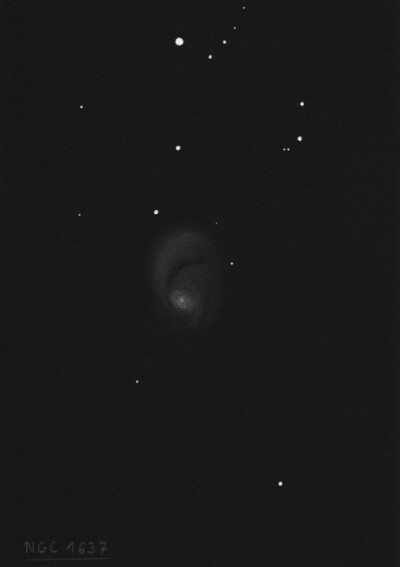
William Herschel discovered NGC 1637 = H I-122 = h327 on 1 Feb 1786 (sweep 518) and reported "cB, vL, iR, bM, easily resolvable, 5' or 6' diameter." John Herschel made two observations from Slough, England ? once describing it as "bright" and another time as "pretty faint". Fifteen observations were made at Birr Castle and noted as a spiral on 19 Dec 1848 (included in the LdR's 1850 list of "Spiral or curvilinear" nebulae). R.J. Mitchell, observing on 26 Dec 1856, added "Suspect very strongly that it is a right handed spiral, but the outlying neby is vF." He made a sketch two nights later (LdR's 1861 publication, Plate XXV, figure 9).
Albert Le Sueur sketched it using the 48" Melbourne Telescope with an elongated core (WSW-ENE) offset to the south side (halo more extensive to the north) and subtle structure in the halo (unpublished plate VII, figure 83). It was later observed by both Joseph Turner and Pietro Baracchi (11 Mar 1885).
200/250mm - 8" (10/4/80): faint, oval, fairly small.
300/350mm - 13.1" (12/18/82): fairly faint, large, diffuse, elongated 4:3 SW-NE, weak concentration. A mag 13 star is 2.1' NE of center. Located midway between Mu Eridani (V = 4.0) 1? ESE and 51 Eridani (V = 5.2) 1? WNW.
900/1200mm - 48" (11/2/13): bright, large, slightly elongated SSW-NNE, 3'x2.5'. Contains a large bright core with an elongated bright nucleus that appears to be a bar oriented E-W. The appearance is quite irregular due a thick, fairly prominent spiral arm that curves north-south along the eastern side of the halo and bending west as it curves counterclockwise on the north side. A darker gap was evident between the slightly brighter inner edge of this thick arm and the core. A small section of another spiral arm is attached at the SW side of the core. The SW side of the halo is fainter and not as extensive as the NE side, so the galaxy has a lopsided appearance.
Notes by Steve Gottlieb
NGC 1600
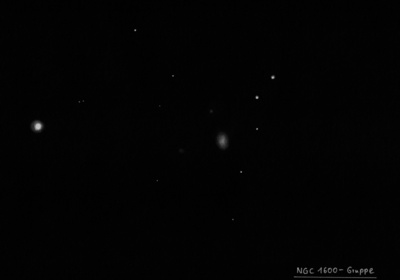
William Herschel discovered NGC 1600 = H I-158 = h319 on 26 Nov 1786 (sweep 638) and recorded "pB, pL, irr R, vgmbM." Just two nights later (sweep 640) he noted "cB, pS, mbB." John Herschel made 4 observations and the observers on LdR's 72" made 5 observations of the field, discovering NGC 1601, 1603 and 1606.
300/350mm - 13" (12/18/82): fairly bright, small, round, broad concentration.
400/500mm - 17.5" (2/1/92): bright, moderately large, elongated 4:3 N-S, broadly concentrated halo, almost stellar nucleus. Brightest in a large group with NGC 1601 1.6' N, NGC 1603 2.6' ESE and NGC 1606 7' NE. Other members include NGC 1599, NGC 1604, NGC 1607, NGC 1609, NGC 1611, NGC 1612, NGC 1613 and IC 373. Located 12' SE of mag 7.8 SAO 131262 12' NW and 15' ESE of mag 9 SAO 131258.
600/800mm - 24" (2/24/20): at 260x and 375x; very bright, fairly large, slightly elongated N-S, ~1.6'x1.2', very bright core, stellar nucleus, brighter along a N-S central axis. Two adjacent NGC companions (1601 and 1603).
Notes by Steve Gottlieb
NGC 1386
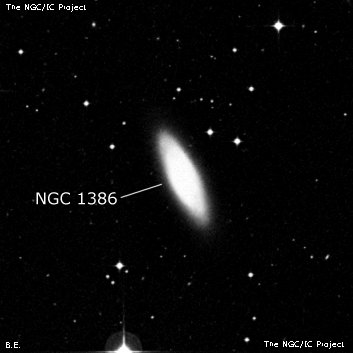
Julius Schmidt discovered NGC 1386 on 19 Jan 1865 with the 6.2-inch refractor at the Athens Observatory during his survey of the Fornax Cluster (nebula "g" in his table). His position is at the east edge of ESO 358-035 = PGC 13333.
200/250mm - 8" (1/1/84): fairly faint, bright core, almost round.
300/350mm - 13.1" (1/1/84): moderately bright, elongated 2:1 SW-NE, bright core. NGC 1389 lies 16' NNE and NGC 1369 15' S (not observed). Located 5.2' NNW of mag 9.5 SAO 194401. Member of the Fornax I cluster.
400/500mm - 18" (12/17/11): bright or very bright, large, elongated 5:2 SW-NE, 2.5'x1.0'. Gradually brighter outer halo, then sharply concentrated with a very bright, elongated core that increases towards the center. NGC 1389 lies 16' NNE.
Notes by Steve Gottlieb
NGC 1421
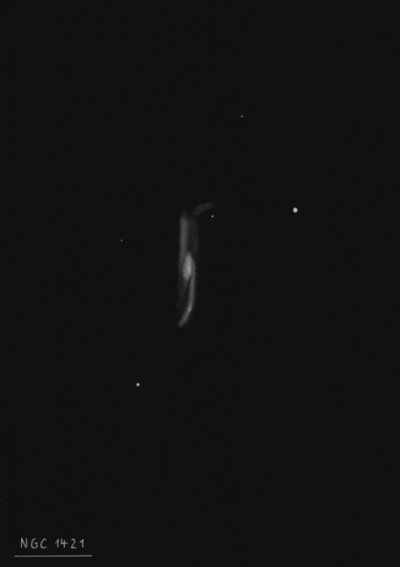
William Herschel discovered NGC 1421 = H II-291 = h2577 on 1 Feb 1785 (sweep 364) and noted "pF, mE in the direction of the meridian, between 3 and 4' l and about 1' broad, resolvable." JH observed this galaxy on 8 Dec 1835 and recorded "F, vmE, vlbM, 3' l, 20" br; pos. = 184.2 degrees." Dreyer and Lord Rosse made a detailed observation with the 72" on 14 Oct 1876: "F, mE 178.7?, about 4' long; F* (17m +/- ) p near the on end, 38.7" distant, the brighter part of the neb seems abruptly terminated just foll the star, towards which it also appears curved; eF* or knot in neb foll the *17m."
200/250mm - 8" (11/28/81): very faint, moderately large, elongated N-S. A distinctive 6.5' collinear string consisting of four stars mag 10-12 oriented NW-SE begins 8' S.
400/500mm - 17.5" (11/2/91): fairly bright, fairly large, very elongated 4:1 N-S, 3.0'x0.7', broad weak concentration, fades towards tips. The surface brightness has a patchy or mottled appearance. The southern tip is slightly fainter than the northern edge. A mag 13 star is 2.8' NE of center.
Notes by Steve Gottlieb
NGC 1426
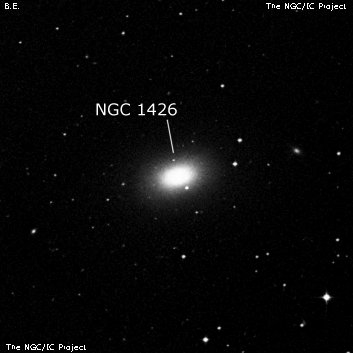
William Herschel discovered NGC 1426 = H III-248 = h2578 on 9 Dec 1784 (sweep 331) and recorded "vF, vS, lE." JH made two observations from the CGH, first calling it "F" and then "B", probably due to varying sky conditions.
300/350mm - 13.1" (10/10/86): fairly bright, small, round, bright core, stellar nucleus.
Notes by Steve Gottlieb
NGC 1357
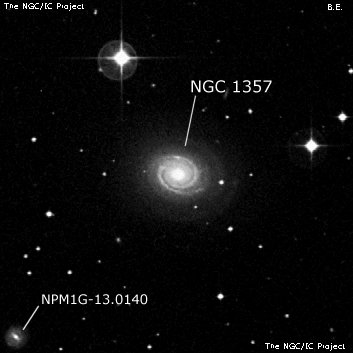
William Herschel discovered NGC 1357 = H II-290 = h2548 on 1 Feb 1785 (sweep 364) and recorded "F, pL, R, bM, about 5 or 6' south preceding of a pretty large star." JH logged it twice from the Cape of Good Hope and noted on 8 Dec 1835 "pF, pL, R, 40", near three stars, two of which are 10th mag." Sir Robert Ball, observing with the 72" at Birr Castle on 13 Nov 1866, remarked "cB, pL, bM, either double or with a star [correct] very closely preceding. Observations interrupted by the superb display of shooting stars." According to Wikipedia, the 1866 Leonids produced hundreds per minute and a few thousand per hour in Europe.
300/350mm - 13.1" (12/7/85): fairly bright, moderately large, round, bright core. Forms the vertex of an isosceles right triangle with mag 8.1 SAO 149035 4' NNE and mag 9.2 SAO 149028 4' WNW.
Notes by Steve Gottlieb
NGC 1291
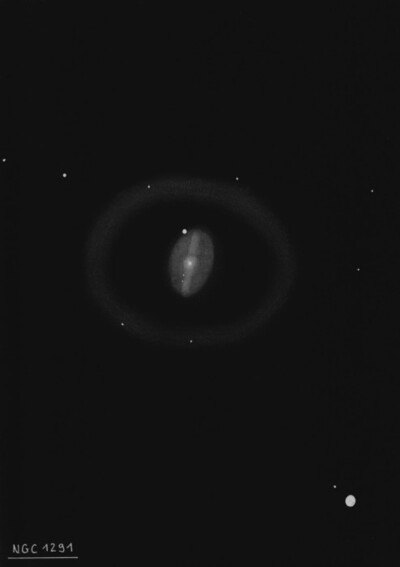
James Dunlop discovered NGC 1291 = D 487 = h2521 on 2 Sep 1826 with his 9" reflector at Parramatta and recorded "a pretty bright round nebula, about 1.5' diameter, very bright and condensed to the centre, and very faint at the margin; with a very small star about 1' north, but not involved.". His position is 4' too far ESE. John Herschel observed this galaxy on 1 Nov 1836 and also catalogued h2518 (later NGC 1269). The declination and descriptions are identical for his two entries, but differ by 2.6 minutes of time. Clearly, Herschel was confused and recorded the object twice. So, NGC 1269 = NGC 1291.
On a second sweep Herschel described the galaxy as "Globular; vB, R, 1st gradually, then suddenly very mbM; r, mottled, but not resolved.", so Dreyer identified this galaxy as a globular in the NGC description. In a 1908 paper in Annals of the Harvard College Observatory, Solon Bailey expressed his doubt on the object's nature: "This object is given as a globular cluster in the NGC. This appears probable, although it is not resolved on the [24"] Bruce plates [at Arequipa]." He later included it in a list of uncertain or not probable globular star cluster.
Based on the photographs taken 30-inch reflector at the Cordoba observatory in Argentina, Charles Perrine first described the large outer ring in 1922 as "about one and one-half turns of a helix, the doubled portion (showing two streams) being to the north of the nuclear portion of the nebula. The diameter of the helix is about 7'."
300/350mm - 13.1" (10/10/86): very bright, moderately large, round, very bright core, almost stellar nucleus, large faint halo. A star is involved on the north side.
400/500mm - 17.5" (8/31/86): very bright, fairly large, contains a very bright, large core. A mag 12 star is just off the north end 1.7' from the center. Mag 8 SAO 216239 lies 11' SSW. Viewed at only 10? elevation.
600/800mm - 25" (3/31/19 - OzSky): at 244x; extremely bright, large, elongated 4:3 NNW-SSE, ~3.5'x2.7', very bright core with an intense nucleus. A mag 12.2 star is is superimposed at the N edge 1.7' from center and a second very faint star is superimposed in the halo on the south side. The huge outer ring was not noticed.
Notes by Steve Gottlieb
NGC 1532
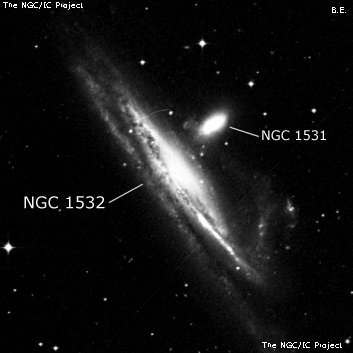
James Dunlop discovered NGC 1532 = D 600 = h2621 on 29 Oct 1826 with his 9" reflector from Parramatta, NSW, and described "an extremely faint ill-defined nebula, rather elongated in the direction of the meridian, gradualy a little brighter towards the centre." Dunlop's position (single observation) is 7' too far east. John Herschel observed this showpiece galaxy on 3 differents sweeps, recording it first on 19 Oct 1835 as "B, vL, vmE, 5' long; A fine and curious object. The following and brighter of two [with NGC 1531]. In the ray is either a vF * or a knot in the nebula."
Joseph Turner sketched the pair on 30 Nov 1875 using the 48-inch Great Melbourne Telescope (unpublished plate II, figure 14) as well as Albert Le Sueur (unpublished plate VII, figure 82). Turner's sketch shows a brighter thin streak along the south edge of the southwest end of the galaxy.
300/350mm - 13.1" (12/22/84): bright, large, pretty edge-on 5:1 SW-NE, very bright nucleus, thin extensions. Forms a close pair with NGC 1531 1.6' NW.
600/800mm - 24" (12/1/16): SN 2016 iae, a type Ic supernova discovered on 7 Nov 2016, was observed 15" E and 52" N of center of NGC 1532, along the western edge of the spiral arm extending NNE. The major axis of the companion NGC 1531 off the west side, pointed exactly to an extremely faint "star". In poor seeing, the supernova was only occasionally visible, perhaps mag 15.5.
900/1200mm - 48" (10/22/11): this showpiece edge-on stretches 7'x1.2', tilting SW-NE. The galaxy is sharply concentrated with a large, elongated, very bright core that is mottled and increases to the center. The surface is knotty, streaky and mottled. A striking dust lane runs along the major axis, slicing the galaxy asymmetrically into two parts to the south of the core. The dust lane expands to a larger, elongated (dark) patch on the NE side of the core. The section to the south of the dust lane is much thinner and brightens to a prominent, very bright knotty 1.5' streak on the SW end [brightest part of a tidal tail extending towards NGC 1531]. A very faint star (B = 18.2) is close to the southwest tip of the bright streak. The fainter strip of galaxy south of the dust lane near the core appears patchy, probably due to dust and star-forming knots. Just northwest of the core is NGC 1531, a bright elliptical that angles perpendicular to the core and forms a striking pair.
IC 2041 lies 7' NE of center, close following the NE tip of NGC 1532. It appeared fairly bright, fairly small, oval 3:2 NW-SE, ~35"x24", small bright core.
Notes by Steve Gottlieb
NGC 1084
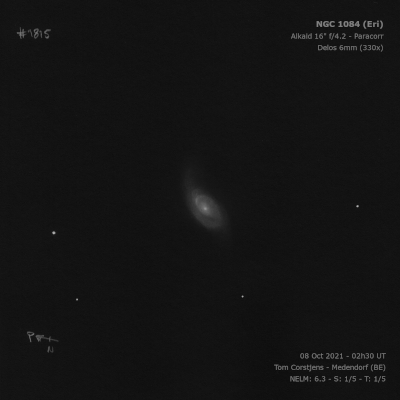
William Herschel discovered NGC 1084 = H I-64 = h264 on 10 Jan 1785 (sweep 355). He recorded "vB, pL, lE, mbM" and measured an accurate position.
The galaxy was observed 8 times at Birr Castle (earliest by Johnson Stoney on 12 Nov 1848). On 16 Oct 1855, assistant R.J. Mitchell called this a "Fine oval neb, has nucl, light mottled, sometimes I thought I saw a dark bay north of Nucl, certainly the neb is brighter along n and nf side than in the part intervening between that and the nucleus". Lassell's sketch shows a very tight spiral wrapping 1 1/2 revolutions around a stellar nucleus. He noted "A very obscure faint spiral nebula of apparently this form with power 760.?
200/250mm - 8" (10/13/81): bright, moderately large, elongated. Three mag 9-10 stars lie 13' N, 15' NNE and 16' NNW.
400/500mm - 17.5" (10/21/95): very bright, fairly large, elongated 2:1 SSW-NNE, 2.5'x1.2', broad concentration with a large bright core. Irregular mottled appearance or dust or dark lanes on the east side. The west side has a symmetric bulging appearance but there are dark indentations or bays on the NE and SE sides of the halo (probably between the spiral arms).
Notes by Steve Gottlieb
NGC 1309
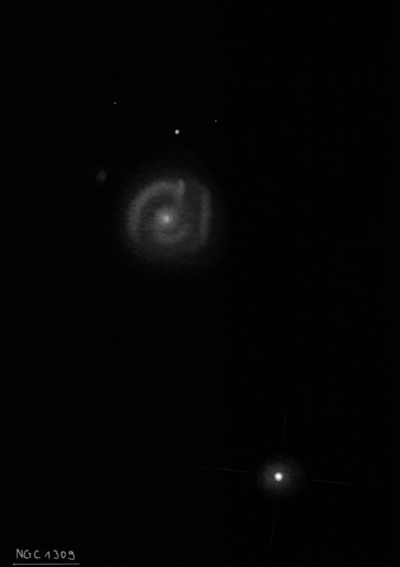
William Herschel discovered NGC 1309 = H I-106 = h2523 on 3 Oct 1785 (sweep 451), logging it as "cB, cL, iR, bM, 3' diameter." JH described it as "pF, R, glbM, pos from a * 7 mag = 31?, difference in RA 7.5 sec, * 4' S."
200/250mm - 8" (11/28/81): fairly faint, small, round. A mag 8 star is 4' SW.
400/500mm - 17.5" (1/1/92): fairly bright, moderately large, halo gradually increases to brighter middle, faint almost stellar nucleus, well-defined halo slightly elongated SW-NE. Located 4' NE of mag 7.5 SAO 148921.
Notes by Steve Gottlieb
NGC 1253
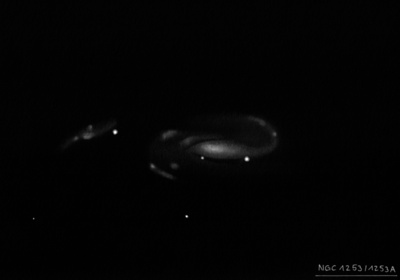
William Herschel discovered NGC 1253 = H IV-17 on 20 Sep 1784 (sweep 280), reporting "a small star with a vF nebulous brush following, discovered with 240x. The brush was faint and about 1.5' or 2' long. A star on each side which viewed were free from that brush that I drew them in the same part of the field." His position was 6' too far south (at the beginning of this sweep, he noted "The rope being broken the PD is coarsely marked in revolutions of the axel"). d'Arrest corrected the position on 4 Jan 1864 and made a total of 4 accurate positions.
400/500mm - 17.5" (1/7/89): moderately bright, oval ~E-W, no central brightening but contains a slightly brighter knot at the NE end. A mag 12 star is involved at the west end 52" from the center and a mag 11 star is 2.9' ENE of center. Forms a double system with NGC 1253A 3.7' ENE (just following the mag 11 star) which was not seen.
600/800mm - 24" (12/1/13): NGC 1253A was picked up as a very faint to faint glow, elongated 2:1 E-W, 0.4'x0.2' (central region seen), low surface brightness. Situated 3.9' ENE of much brighter NGC 1253 and just 0.9' NE of a mag 12 star. NGC 1253 showed a little structure but I didn't take notes.
900/1200mm - 48" (10/23/11): very bright, very large, elongated ~5:2 WSW-ENE, ~4'x1.6'. Contains a large, very bright elongated core that gradually increases to the center. A mag 12.5 star is superimposed just SW of the central region. A spiral arm emerges from the galaxy on the ENE end and curls sharply clockwise towards the SW on the follwing end of the galaxy and quickly dims. The arm appears patchy with a couple of small knots near the outer edge (~1.6' from center). The arm on the west end is harder to make out as it emerges from the central region near the superimposed star and is not as well defined, appearing more as a hazy, mottled region with some brighter patches. A mag 12 star lies 3' ENE and just beyond the star is NGC 1253A, a low surface brightness dwarf. NGC 1253A appeared fairly faint, large, irregular, roughly oval 3:2 E-W, 1.2'x0.8', small brighter core, very patchy appearance (contains HII knots). The nearby mag 12 star is just off the SW side.
Notes by Steve Gottlieb
NGC 1518
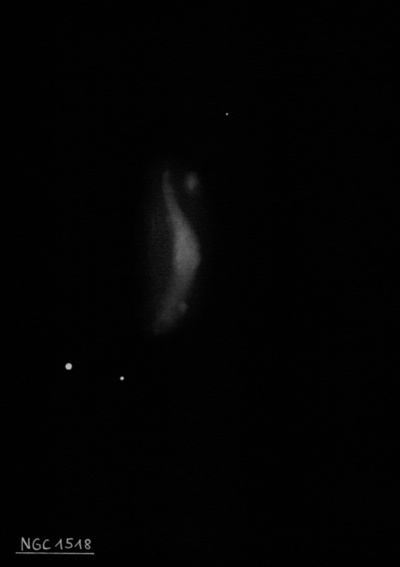
John Herschel discovered NGC 1518 = h2611 on 6 Jan 1785 and recorded "B; L; pmE; gbM; has a *8 mag south-preceding 3' or 4' dist." There is nothing at his position but ESO 550-007 is 1.0 minute of RA east and his description applies. Herbert Howe measured an accurate position in 1898 using the 20" refractor at Chamberlin Observatory (repeated in the IC 2 notes) and gave the position angle as 200?. Sir Robert Ball, observing with Lord Rosse's 72" on 25 Jan 1867, wrote "I have little doubt that there are interesting details in the form of this object but the altitude is low (15?) and the night was bad. The middle part is bright but apparently excentric if (as was suspected) there is a branch proceeding south and somewhat curved towards the preceding side."
200/250mm - 8" (1/1/84): faint, very elongated 3:1 streak SW-NE. A mag 10 star 2.5' SW interferes with viewing. NGC 1521 lies 22' ENE.
400/500mm - 17.5" (12/28/94): fairly faint, very elongated 3:1 SW-NE, 2.7'x0.9', weak concentration. Located 2.5' NE of a mag 9.5 star. Appears asymmetric with the SW end close to the bright star much fainter than the main body.
Notes by Steve Gottlieb
NGC 1241
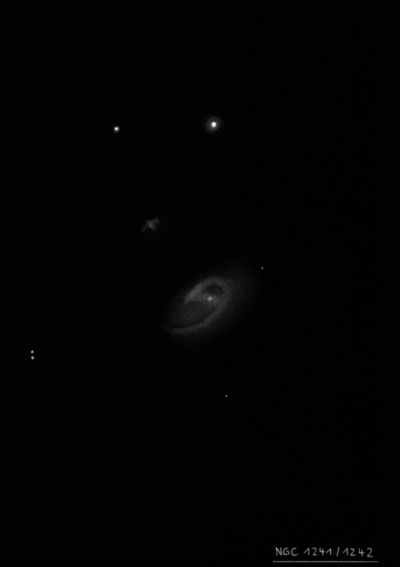
William Herschel discovered NGC 1241 = H II-286 = h289 = h2510 on 10 Jan 1785 (sweep 355) and recorded "F, pL, R, lbM, south of a small star." John Herschel observed this galaxy both at Slough, England, calling it "eF" and "pB" on two observations, and at the Cape of Good Hope where he logged "F, pmE, 50", the preceding of two [with NGC 243]."
300/350mm - 13.1" (12/7/85): moderately bright, round, bright core surrounded by a diffuse halo. Forms a close pair with fainter NGC 1242 1.6' NE. Located 3.0' due south of mag 9.0 SAO 130329.
600/800mm - 24" (12/28/13): fairly bright, moderately large, oval 2:1 NW-SE, 2'x1', contains a large bright core that increases towards the center. There was a hint of arm structure in the outer halo. Forms a pair with NGC 1242 1.7' NE with both galaxies just south of a mag 9.3 star.
Notes by Steve Gottlieb
NGC 1358
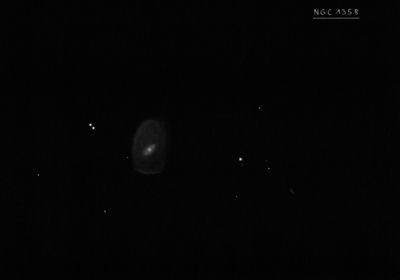
William Herschel discovered NGC 1358 = H III-446 = h302 on 5 Oct 1785 (sweep 457) and noted "vF, S, between some small stars." His position is too far south, but John Herschel measured an accurate position (two observations) used in the NGC.
300/350mm - 13" (12/18/82): very faint, small, elongated N-S.
400/500mm - 17.5" (11/25/87): moderately bright, moderately large, irregularly round, sharp concentration. A pretty mag 13 double star at 15" separation is 1.7' ENE. Located 8' W of a mag 10 star. Forms a pair with NGC 1355 6.8' NW.
Notes by Steve Gottlieb
NGC 1359
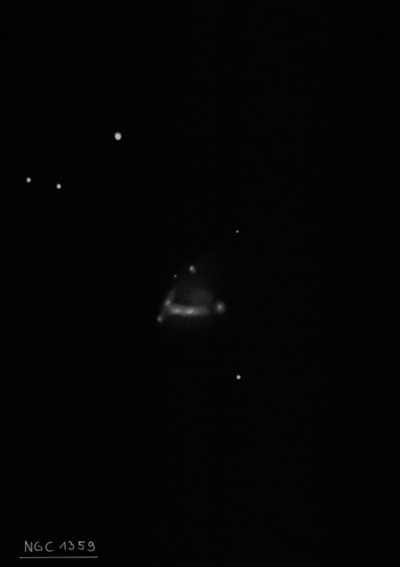
John Herschel discovered NGC 1359 = h2550 on 12 Oct 1836 and recorded "F, L, R, vglbM, 2'." His position matches ESO 548-039 = PGC 13190.
400/500mm - 17.5" (11/17/01): fairly large oval 4:3 NW-SE, 3.0'x2.5' WNW-ESE, fairly low surface brightness with no significant concentration. This galaxy has a disturbed, knotty appearance that was not picked up visually. Brightest in a small group with ESO 548-044 8.5' NE and part of the larger NGC 1407 group.
Notes by Steve Gottlieb
NGC 1625
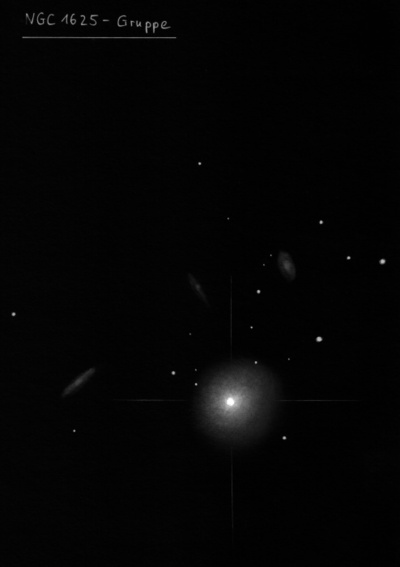
John Herschel discovered NGC 1625 = h322 on 24 Nov 1827 (sweep 109) and recorded "vF; E; 45? np sf; sbM; follows nu Eridani 41sec." His position and description matches MCG -01-12-038 = PGC 15654. This is the third of three edge-ons near Nu Eridani with NGC 1618 (discovered by WH) and NGC 1622 (discovered by George Stoney at Birr Castle).
300/350mm - 13" (12/18/82): very faint, very elongated NW-SE.
400/500mm - 17.5" (10/12/85): fairly faint, edge-on 4:1 NW-SE, 1.4'x0.3'. A mag 14 star is at the NW tip 0.7' from center. Third of three edge-on systems with NGC 1622 10' NW and NGC 1618 18' NW. Located 10' ENE of Nu Eridani.
900/1200mm - 48" (11/2/13): brightest of three prominent edge-ons near mag 3.9 Nu Eridani. At 287x appeared extremely bright, large, edge-on 4:1 NW-SE, 2.0'x0.45', well concentrated with a very bright, elongated core that increases to a stellar nucleus. A mag 14.2 star is at the NW edge. There appears to be an elongated galaxy superimposed at the SE edge, but I didn't look for or notice this object. Located 12' ENE of Nu.
Notes by Steve Gottlieb
NGC 1721
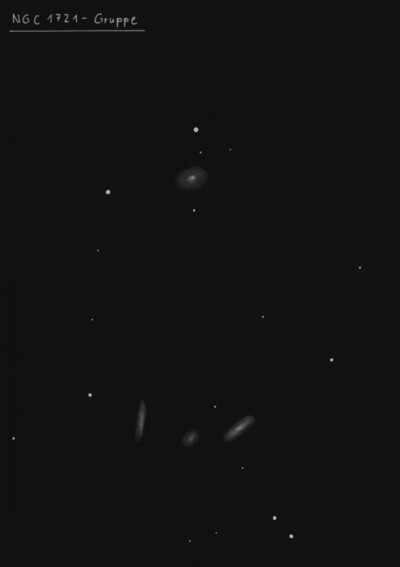
E.E. Barnard discovered NGC 1721, along with NGC 1725 and 1728, on 10 Nov 1885 with the 6-inch Cooke Refractor at Vanderbilt Observatory. In Sidereal Messenger, volume 5, he described "three small novae close together; difficult; rather faint, all three probably elongated north and south. A good many stars in field. It requires considerable power to make these nebulae out distinctly, a power of 120 on the 6-inch is about the lowest with which they can be seen.
Lewis Swift observed the trio (Sw. III-32, III-33 and III-34) a month later on 2 Dec 1885 after being notified by Barnard, but he mistakenly reported them as new again in his third discovery list, which was published in 1886! Barnard immediately responded in AN 2755 to claim prior discovery and document their correspondence. Swift acknowledged Barnard's prior discovery in the errata to his 5th list. Dreyer credited both Barnard and Swift in the NGC, despite Swift's mistae.
400/500mm - 17.5" (12/3/88): fairly faint, small, slightly elongated, broadly concentrated halo. A mag 14 star is off the NE side 1' from the center. In a close trio with NGC 1725 1.6' SE and NGC 1728 2.5' ESE. In addtion, NGC 1723 lies 8.5' NNE.
600/800mm - 24" (12/28/13): moderately to fairly bright, fairly small, high surface brightness, elongated 3:2 NW-SE, ~45"x30". Contains a small, bright irregular core. A mag 14 star is 0.8' NE of center. First in a close trio (KTS 28) with NGC 1725 and 1728.
Notes by Steve Gottlieb
NGC 1614
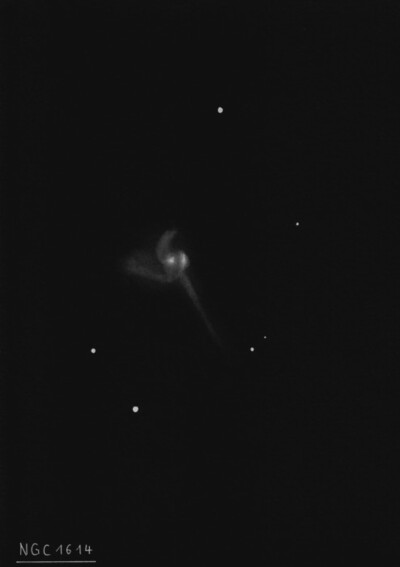
Lewis Swift discovered NGC 1614 = Sw. III-30 on 29 Dec 1885 with his 16" refractor. His RA was 21 seconds too large. Herbert Howe measured an accurate position in 1898 using the 20" refractor at Chamberlin Observatory (repeated in the IC 2 notes).
400/500mm - 17.5" (10/29/94): fairly faint, fairly small, elongated 4:3 SSW-NNE, 0.8'x0.6', broad concentration. A mag 13 star is 2.0' S of center.
Notes by Steve Gottlieb
IC 1870
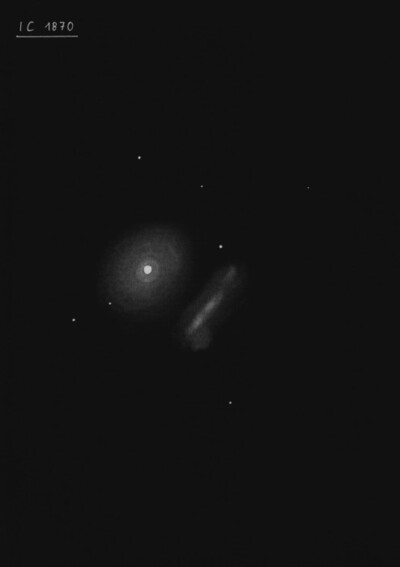
E.E. Barnard discovered IC 1870 on 28 Nov 1888 with the 12-inch refractor at Lick Observatory. He noted "vF, R, vgbM, v difficult" and made a rough sketch (in his logbook) with the nearby bright star. Barnard notified Dreyer directly of the discovery.
600/800mm - 24" (1/28/17): at 282x; fairly faint, moderately large, elongated NW-SE, ~0.9'x0.5', increases in size with averted vision. Contains a small brighter core. Low surface brightness but slightly irregular and patchy. Situated just 1.7' WSW of mag 7.7 HD 18463, which significantly interferes with the view! A mag 12 star is 1.6' NNW.
Notes by Steve Gottlieb
NGC 1228
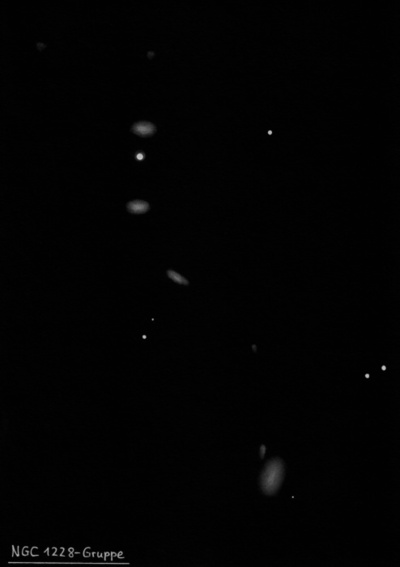
Francis Leavenworth discovered NGC 1228 = LM 2-359 (along with NGC 1229 = II-360) in 1886 with the 26" refractor at the Leander McCormick Observatory, recording "mag 15.5, 0.1', R, gbM, 1st of 2". There is nothing at his position, but 1 min of time west is ESO 480-032 = PGC 11735. Herbert Howe measured an accurate position in 1899-00 using the 20" refractor at Chamberlin Observatory (repeated in the IC 2 notes).
400/500mm - 17.5" (11/10/96): faint, small, elongated 3:2 SW-NE, 0.8'x0.6'. A mag 13 star is 50" S. In a group with NGC 1229 2.2' S. NGC 1230 lies 3.8' SSE, and IC 1892 8.6' SSE.
Notes by Steve Gottlieb
NGC 1540
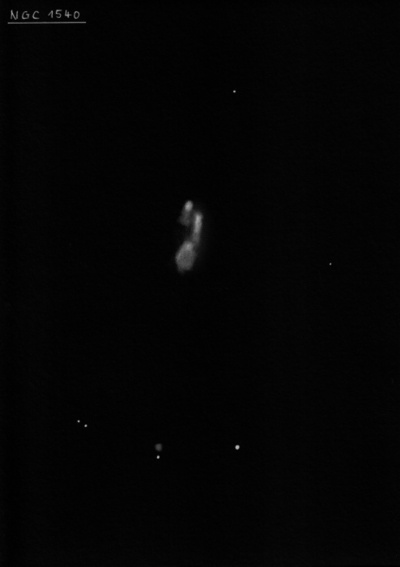
John Herschel discovered NGC 1540 = h2626 on 6 Nov 1834 and recorded "vF; E; resolvable. Rather a doubtful object. He confirmed the object, though, on sweep 643 and his position matches ESO 430-014 = PGC 14733. This is an interacting pair (AM 0413-283) with separation 0.55'. My visual observation recorded the southern galaxy as brighter and larger and Harold Corwin concurs that the southern object is probably the one viewed by Herschel. He suggests, though, assigning NGC 1540 to the entire system.
400/500mm - 18" (1/21/04): fairly faint, fairly small, elongated 3:2 ~N-S, ~0.8'x0.5'. Appears to have a star or quasi-stellar knot at the north tip -- this is actually an interacting galaxy [NGC 1540B]! Located 8' SW mag 9.4 SAO 169272 (wide double).
Notes by Steve Gottlieb
NGC 1699
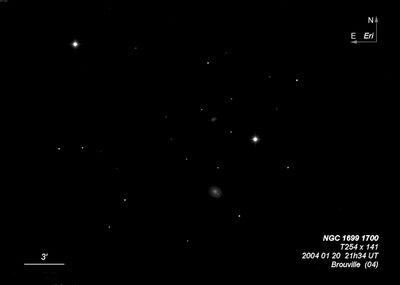
Samuel Hunter discovered NGC 1699 = Sw. VI-21 on 13 Feb 1860 with LdR's 72? (too late for inclusion in LdR?s 1861 publication) while observing the field of NGC 1700. He noted "a smaller one nf, scarcely perceptible in finder and vF, above a F *." NGC 1699 is Hunter?s only deep sky discovery while an observing assistant at Birr Castle. Lewis Swift independently found this galaxy on 22 Dec 1886 and reported it as new in list VI-21. Dreyer credited both observers in the NGC.
400/500mm - 17.5" (12/23/89): very faint, small, slightly elongated N-S, even surface brightness. Located just 4' ENE of mag 7.8 SAO 131619 and bracketed by two mag 13 stars 1.8' SW and 1.1' NE of center. Forms a pair with brighter NGC 1700 6.7' S.
Notes by Steve Gottlieb
HCG 21
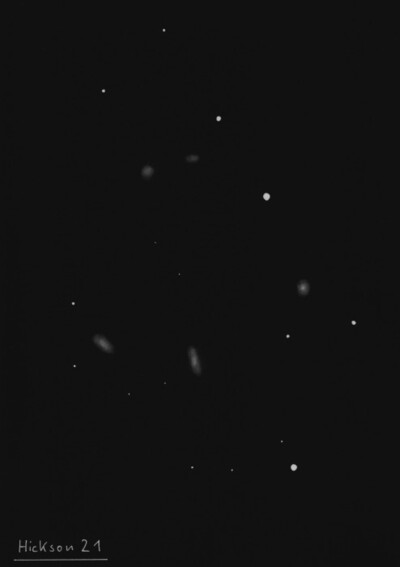
| Type | GALCL [S3] |
| RA | 02:45:17.7 |
| Dec | -17:37:10.0 |
| major_axis | 14.0' |
| mag | 10.1 |
| surface_bright | 99.9 |
HCG 22
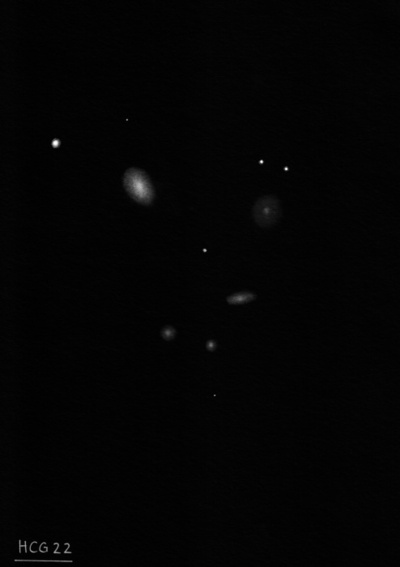
| Type | GALCL [E1] |
| RA | 03:03:31.3 |
| Dec | -15:40:33.0 |
| major_axis | 6.5' |
| mag | 10.5 |
| surface_bright | 99.9 |
HCG 23
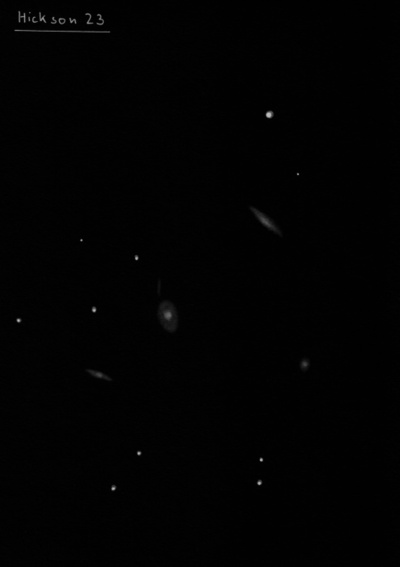
| Type | GALCL [S3] |
| RA | 03:07:06.5 |
| Dec | -09:35:08.0 |
| major_axis | 9.19' |
| mag | 11.2 |
| surface_bright | 99.9 |
HCG 30

| Type | GALCL [S3] |
| RA | 04:36:28.6 |
| Dec | -02:49:57.0 |
| major_axis | 5.9' |
| mag | 11.6 |
| surface_bright | 99.9 |
HCG 24
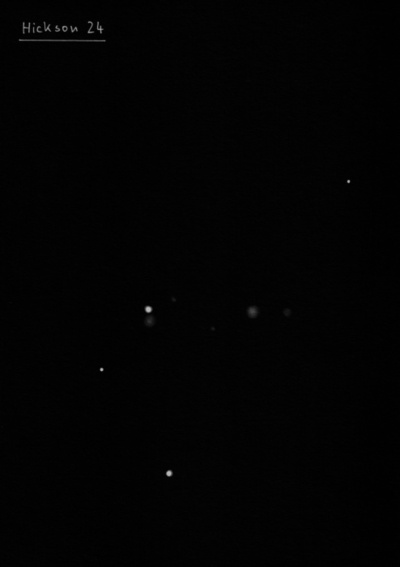
| Type | GALCL [E2] |
| RA | 03:20:18.9 |
| Dec | -10:51:53.0 |
| major_axis | 3.1' |
| mag | 12.7 |
| surface_bright | 99.9 |
HCG 26
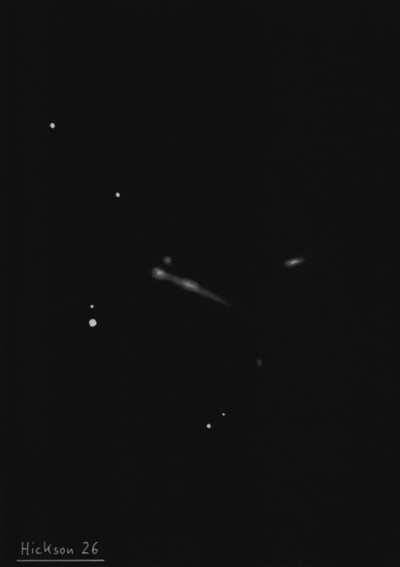
| Type | GALCL [S2] |
| RA | 03:21:54.2 |
| Dec | -13:38:45.0 |
| major_axis | 2.5' |
| mag | 12.7 |
| surface_bright | 99.9 |
HCG 28
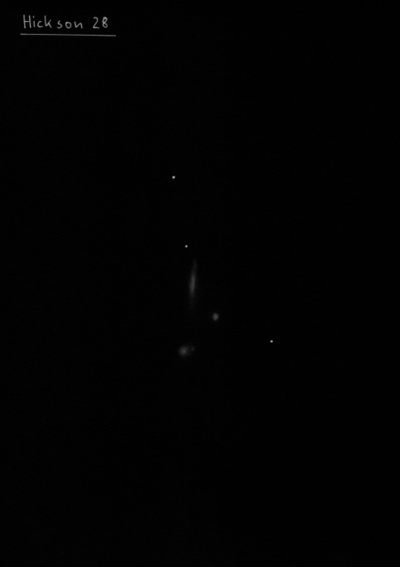
| Type | GALCL [S1] |
| RA | 04:27:19.5 |
| Dec | -10:19:00.0 |
| major_axis | 96.0'' |
| mag | 13.2 |
| surface_bright | 99.9 |
HCG 31
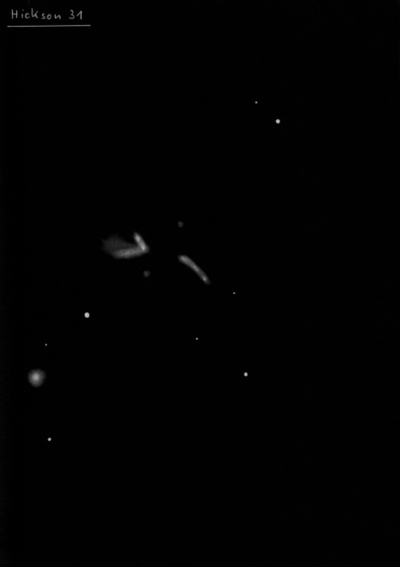
| Type | GALCL [S2] |
| RA | 05:01:36.9 |
| Dec | -04:15:24.0 |
| major_axis | 72.0'' |
| mag | 13.5 |
| surface_bright | 99.9 |
HCG 27
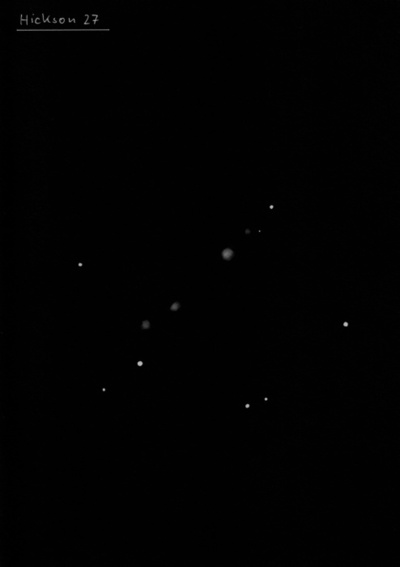
| Type | GALCL [S3] |
| RA | 04:19:21.2 |
| Dec | -11:42:35.0 |
| major_axis | 4.9' |
| mag | 14.0 |
| surface_bright | 99.9 |
HCG 29
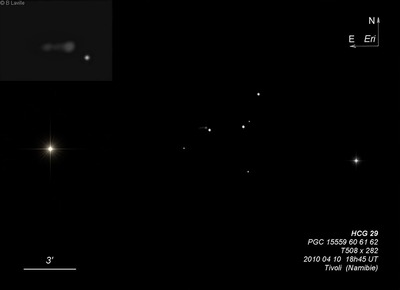
| Type | GALCL [S2] |
| RA | 04:34:46.0 |
| Dec | -30:32:50.0 |
| major_axis | 60.0'' |
| mag | 14.8 |
| surface_bright | 99.9 |
